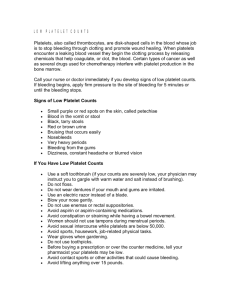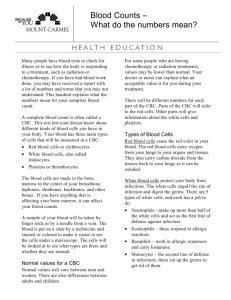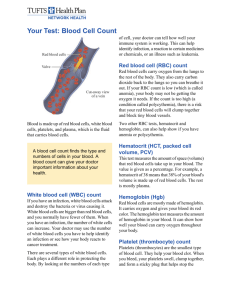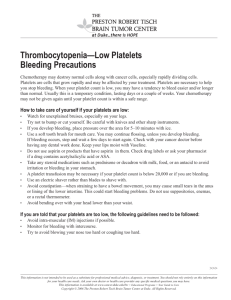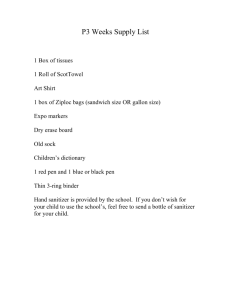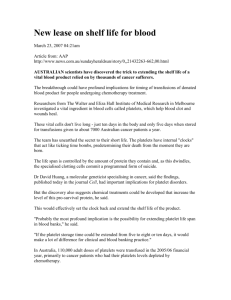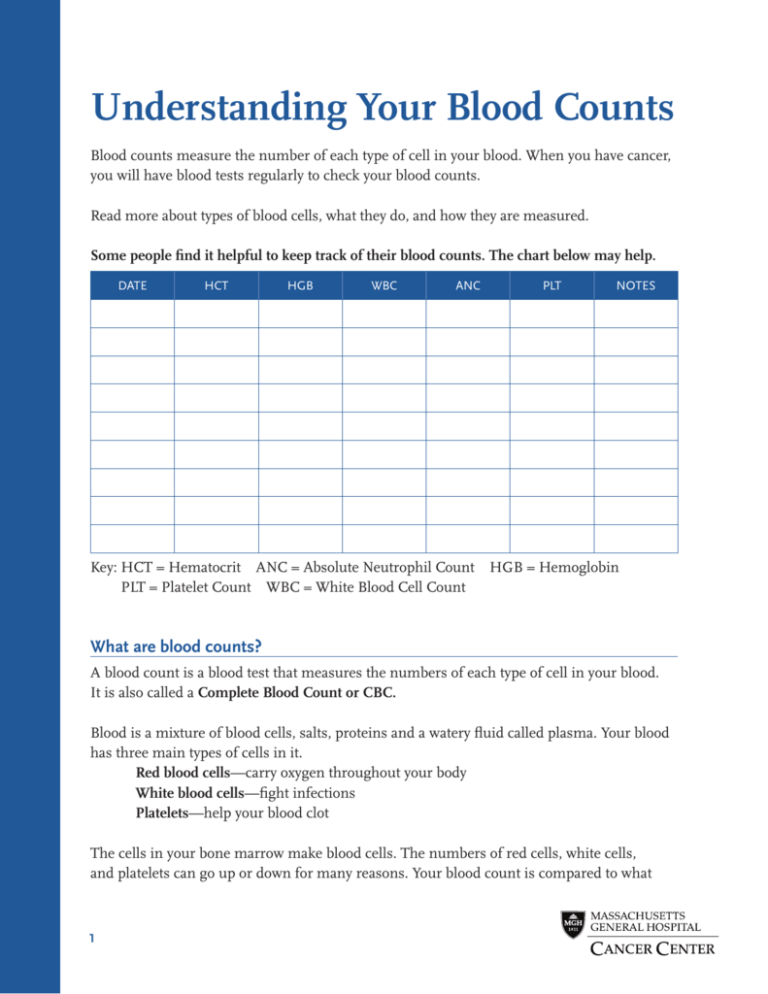
Understanding Your Blood Counts
Blood counts measure the number of each type of cell in your blood. When you have cancer,
you will have blood tests regularly to check your blood counts.
Read more about types of blood cells, what they do, and how they are measured.
Some people find it helpful to keep track of their blood counts. The chart below may help.
DATE
HCT
HGB
WBC
ANC
Key: HCT = Hematocrit ANC = Absolute Neutrophil Count
PLT = Platelet Count WBC = White Blood Cell Count
PLT
NOTES
HGB = Hemoglobin
What are blood counts?
A blood count is a blood test that measures the numbers of each type of cell in your blood.
It is also called a Complete Blood Count or CBC.
Blood is a mixture of blood cells, salts, proteins and a watery fluid called plasma. Your blood
has three main types of cells in it.
Red blood cells—carry oxygen throughout your body
White blood cells—fight infections
Platelets—help your blood clot
The cells in your bone marrow make blood cells. The numbers of red cells, white cells,
and platelets can go up or down for many reasons. Your blood count is compared to what
1
is normal for you and others of your age and sex. Any change in your blood count can give
important information to your treatment team. This pamphlet gives you information on
what blood count changes can mean for you and what you can do.
Why is testing my blood so important?
Cancer, chemotherapy, and radiation make it harder for your bone marrow to make new blood
cells. This can cause a change in your blood counts. You may not have any signs or symptoms
of a decrease in your blood counts unless your counts are very low. A blood count is the best
way to watch for any changes in the number of red cells, white cells, and platelets. Many
things can be measured by testing your blood, such as kidney and liver function. Your blood
counts and other blood tests can make a difference in your treatment schedule or medicines.
About Red Blood Cells
Red Blood Cells (RBC) carry oxygen to all the body’s cells. Red blood cells contain a protein
called hemoglobin. Hemoglobin picks up oxygen in the lungs and delivers it to the tissues
everywhere in your body.
How are red blood cells measured?
There are two tests that measure how many red blood cells you have and how well they are
working. One test is the hematocrit, and the other is the hemoglobin. The average numbers
for these tests are different for men and women.
Hematocrit (HCT) measures the portion of your blood made up of red blood cells.
For a person not in treatment, an average hematocrit is:
36 to 46 for women
41 to 53 for men
Hemoglobin (HGB) measures the amount of this oxygen-carrying protein in your
blood. For a person not in treatment, an average hemoglobin is:
12 to 16 for women
13 to 18 for men
Chemotherapy and radiation therapy affect blood counts. Do not expect your blood counts to
be within the average range during treatment. Your doctor will determine what your normal
counts should be during treatment.
What does it mean if my red blood cell count is low?
A low red blood cell count means you do not have enough red blood cells to carry the
amount of oxygen your body normally needs. This is called anemia.
2
What are the symptoms of anemia?
Anemia can make you feel:
• Weak and tired
• Short of breath
• Dizzy or light-headed
• Rapid beating of your heart
Tell your doctor or nurse if you have any of these symptoms.
If your red blood cell count is too low, your doctor may prescribe a medication to increase
your red blood cell count, or recommend a blood transfusion.
What can I do if I feel weak or tired from anemia?
Try these tips:
• Eat well. Protein is a good source of energy.
• Drink lots of water to prevent dehydration.
• Prevent dizziness by standing up or bending over more slowly.
• Pace yourself and let others help you with chores and errands.
• Get a good night’s sleep, and a short nap during the day (1 hour or less).
• Exercise a little each day to build your strength. Take a short walk or try yoga.
About White Blood Cells
White blood cells are part of your body’s defense system against infections. This is called your
immune system. There are different types of white blood cells, and each type has its own job to
do to fight infections. A neutrophil is one type of white blood cell. Neutrophils are the first cells
that respond to an infection.
How are white blood cells measured?
There are two tests that measure the number of white blood cells in your blood. They are the
White Blood Cell Count (WBC) and the Absolute Neutrophil Count (ANC).
WBC (White Blood Count) measures the total number of white blood cells in the
blood. For a person not in treatment, an average white blood count is:
4,000 to 11,000 for men and women
ANC (Absolute Neutrophil Count) measures the number of neutrophils in the blood.
For a person not in treatment, an average neutrophil count is:
Higher than 1,000 for men and women
What does it mean if my white blood cell count is low?
Cancer treatment can make it harder for your bone marrow to produce enough white blood
cells. Having too few white blood cells, especially neutrophils, is called neutropenia. If you
have neutropenia, you are more likely to get infections.
3
What are the symptoms of infection?
There are many symptoms of infection such as:
• Fever—take your temperature at the same time every day. If your temperature
is higher than 100.5, or if you have sweating or chills, call your doctor or nurse
right away.
• Cough or sore throat
• Headache or sinus pain
• Abdominal pain, diarrhea
• Pain or burning when you urinate
• Bloody or cloudy urine
• Swelling or redness anywhere, especially around an IV or catheter
• Mouth sores or lip blisters
• Ear pain or stiff neck
Tell your doctor or nurse if you have any of these symptoms.
If your white blood cell count is too low, your doctor may prescribe a medication to help your
body produce more white blood cells.
How can I protect myself from infections?
Wash your hands well with soap and water:
• After using the bathroom
• Before eating or making meals
• Before preparing medicines
• Before and after doing catheter care
• After shaking hands
• After being in public places
If you do not have soap and water available, use a liquid or gel hand sanitizer.
Read tips on hand washing on page 7.
Other ways to protect yourself from infection:
• Ask your doctor or nurse about getting a flu shot or pneumonia vaccine
• Stay away from people who are sick
• Avoid crowds
• Wash all raw fruits and vegetables
• Wear gloves when gardening or doing yard work
• Do not pick up animal waste—let others clean up after your pets
• Check with your doctor before having a manicure or pedicure
• Use a condom during sex. Be safe!
4
Avoid cuts:
• Use an electric razor
• Wipe yourself gently after going to the bathroom
• Do not use tampons
• Do not pick at sores or pimples
Take extra care of your mouth:
• Brush your teeth with a soft toothbrush
• Brush your teeth after eating and before bed
• Rinse your mouth with saltwater or baking-soda water two to four times a day. Use
one teaspoon of salt or baking soda for every quart of water to make this mix.
Ask your family members to get a flu shot to help protect you.
About Platelets
Platelets are the cells your bone marrow makes to help your blood clot and control bleeding.
Cancer treatment can reduce the number of platelets your body makes. With fewer platelets
you can bleed more easily.
How are platelets measured?
A Platelet Count (PLT) measures how many platelets are in your blood.
For a person not in treatment, an average platelet count (PLT) is:
150,000 to 350,000 for men and women
What does it mean if my platelet count is low?
When your platelet count is low, you have something called thrombocytopenia. A low platelet
count means you are at risk for bleeding and bruising.
What are the signs of a bleeding problem?
• Bleeding from a cut or scratch that does not stop easily
• Easy bruising or many bruises
• Pink or purple splotches on your skin
• Gum bleeding
• Nosebleeds
• Vomit that looks like coffee grounds
• Pink or red urine
• Black or bloody bowel movements
• Bleeding from hemorrhoids
Tell your doctor or nurse if you have any of these problems.
If your platelet count is too low, your doctor may recommend a platelet transfusion or a
medication to help your body produce more platelets.
5
What should I do if my platelet count is low?
To protect yourself from bleeding, follow these suggestions.
Do not:
• Take aspirin, Motrin®, Advil®, Aleve®, or other NSAIDs. These medicines can
make bleeding problems worse.
• Use toothpicks
• Trim your fingernails or toenails too close
• Use tampons
• Use rectal thermometers, suppositories, or enemas
• Play rough sports
Always:
• Brush your teeth with an extra-soft toothbrush
• Use an electric razor
• Be careful using scissors, knives, and other sharp objects
• Avoid constipation because it can cause hemorrhoids to bleed. Talk to your doctor or
nurse about ways to relieve constipation.
Remember, each person is different. The blood count numbers are guidelines for your
treatment team. Your doctor or nurse considers many things when planning your treatment.
Ask them any questions you have about your blood counts.
To Learn More
Come to or call the Maxwell V. Blum Cancer Resource Room in the Yawkey Building, 8th
floor. Have a question? Our staff can help you find information on topics such as treatment,
managing side effects or nutrition. Visit us or call 617.724.1822. We are also on the Web at
massgeneral.org/cancerEducation.
You can also visit the Cancer Resource Room at Mass General North Shore Cancer Center
Lobby.
6
Hand Washing…Do It Right!
Did you know?
Soap and water removes dirt but does not remove all germs. Hand sanitizers like Purell® kill
most of the germs on your skin but do not remove dirt or debris.
What should I use to clean my hands?
Use soap and water:
• When your hands are dirty or soiled
• After using the bathroom
• Before and after eating or preparing food
Sometimes it is best to use both soap and water and a hand sanitizer to remove germs.
Hand washing tips for soap or hand sanitizer.
When using soap and water or a hand sanitizer:
• Rub your hands and fingers together for 20 seconds
• Cover all hand surfaces—Back….Palm….and In Between Fingers
What if soap and water are not available?
Use a hand sanitizer. It is a good idea to use a hand sanitizer after being in crowds or public
places.
How do I choose a hand sanitizer?
A hand sanitizer is a liquid or gel that contains at least 60% alcohol. Purell® is a common
brand or you can use a store brand. Check to see if it says “hand sanitizer” and contains at
least 60% alcohol.
Can I use hand wipes or sprays?
Liquid and gel hand sanitizers are preferred because they cover all the skin surfaces better
than hand wipes or sprays.
Remember: Wash your hands well and often. It is always the best way to protect yourself
from germs.
©
7
PESC 9.12
The General Hospital Corporation, d/b/a Massachusetts General Hospital, 2012.
Revised August 2012, all rights reserved.

